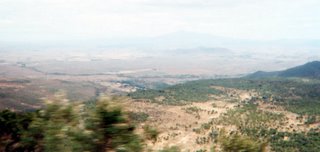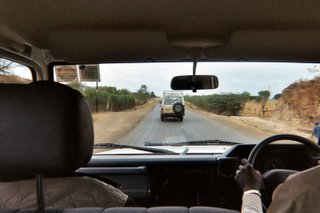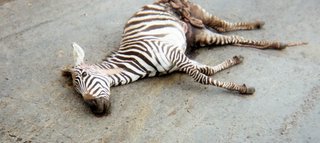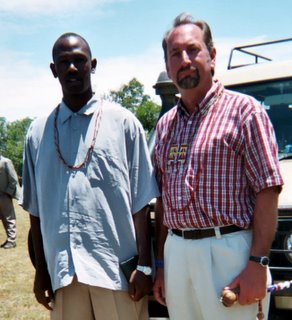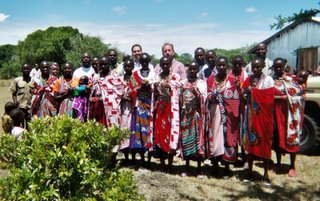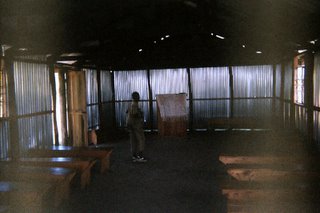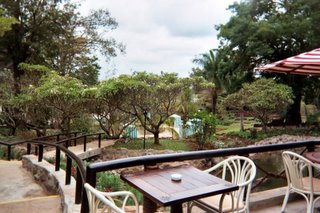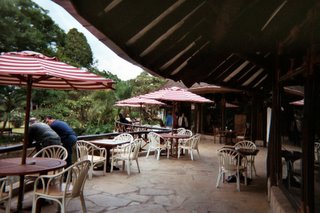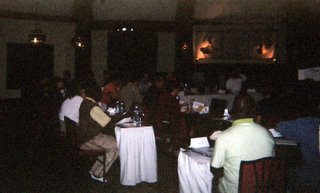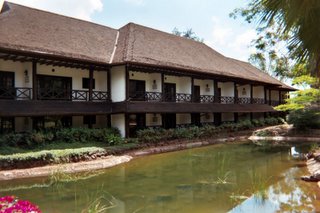On my recent trip to Africa, I disciplined myself to keep a daily journal of what transpired and how I felt about it. These entries are from that journal.
Sunday, October 23, 2005 – Experience #5 – An Evening of Conversation
After a very long and intense day, we shared dinner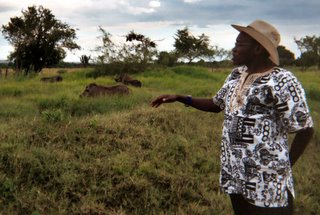 then retired to the “lounge” area for some time to talk. Simon Ole Masi was with us and we were afforded a lengthy time of talking and asking questions. We had been asking him questions all week, but this time we were a bit more intense. We asked questions and picked his brain for about two hours. Our first line of questioning was related to some of the cultural aspects of the various tribes in the area. Here are some highlights of what we learned.
then retired to the “lounge” area for some time to talk. Simon Ole Masi was with us and we were afforded a lengthy time of talking and asking questions. We had been asking him questions all week, but this time we were a bit more intense. We asked questions and picked his brain for about two hours. Our first line of questioning was related to some of the cultural aspects of the various tribes in the area. Here are some highlights of what we learned.
As I have mentioned previously, the Masai are known for several things. They have an incredible running and leaping ability. They also have an astonishing ability to throw their spears with amazing accuracy over great lengths. If my memory is correct they can throw their spears about 100 yards with accuracy that can be measured in inches at times.
There are several items you will notice immediately upon meeting a Masai. You will notice their incredible ear piercing and you will notice that they have had the two bottom center teeth removed. That was two points of questioning that we had to pursue because it is so obvious.
The two lower front teeth in the center of the mouth are removed very soon after they come in replacing what we call “baby teeth” in America. Our first question was pretty obvious: “Why?”
There are two basic reasons, the first is medicinal and the second is appearance related. In times of tribal war, a warrior can be shot with a poisonous arrow and could be in convulsions with clinched teeth. (Tribal warfare ended a few years prior to our arrival here.) By having the two teeth removed, medicine can be inserted into the mouth of the victim even though their teeth are clinched and they are in convulsions. The second reason is that the Masai simply consider a full mouth of teeth to be unattractive. (Before becoming too critical, stop and think of some of the things we do to our bodies and the clothing we endure simply to appear attractive.)
The manner in which the teeth are removed sounds excruciatingly painful. The young boy (who is between six and nine years of age) will be taken in front of the entire village in a very public ceremony to have the teeth removed. He will be given a stick to bite down on and a knife is taken to cut the teeth out. As difficult as that sounds, here is the harder part. The young male (on a rare occasion female) is not allowed to cry or shed a tear. The child has been raised their entire life, and watched this take place on numerous occasions, to know that crying is not an option. If the boy sheds tears, he has forever disgraced his family. They will be known as “the family of the boy who cried.” That is incredible pressure to be on a young boy, but it is engrained in them from birth as a rite of passage.
Richard, the World Vision Area Development Project Director told us that his tribe removes five teeth, and they are knocked out! Ouch!! His tribe is also known for their dress. They believe you should be sure to dress good even if you do not have adequate housing or food. We told him that there are groups in America who also have priorities that lead to similar decisions. It may be clothing, housing, the vehicle you drive, or the gadgets you choose to own, but the principle is the same. It is a matter of priorities.
Piercings are pretty incredible with the Masai. Both genders have multiple ear piercings. The first piercing occurs in the upper portion of the ear in the cartilage area. A hot “poker” will be used and a stick will be inserted in to assure the hole remains open. The hole that ultimately is there is about the size of a toothpick or a little larger.
Later, I cannot recall exactly when, the lower portions of the ear are pierced on some individuals. It is not across the board, so it does not seem to be as culturally mandatory. It seems to be reserved for warriors and a few others. This meaty area will be pierced in the same manner as the upper portion. The difference is that as they get older, larger and larger sticks are inserted into the area until at an older age, the meaty portion of the ear will in some cases hang down almost to the shoulder. I saw one man who pulled this portion above his ear. During dances, necklaces and beads are hung in those portions of the ear and they swing them as they rock back and forth during dances.
I mentioned to them that my two daughters both had several piercings. One had a nose piercing the other had a lip piercing. They looked at me and said, “The lip and nose?! Oh man that must really hurt.” I chuckled and thought; it is all about what your culture tells you is acceptable.
So much for piercing and teeth, next entry we'll talk about their manner of circumcision and FGM and the education we received in a painful cultural learning experience. (Please refrain from posting your jokes and comments. After reading, the next entry the humor will fade quickly.)
Monday, November 28, 2005
Out of Africa: Part 7 (Continued - D) – African Worship & Community Needs
Saturday, November 12, 2005
Out of Africa: Part 7 (Continued - C) – African Worship & Community Needs
On my recent trip to Africa, I disciplined myself to keep a daily journal of what transpired and how I felt about it. These entries are from that journal.
Sunday, October 23, 2005
Experience #4 - The Water Source
We left the dispensary after the 25 minute program that closed with me having a public prayer for the project and the people. We all walked about a mile to a local water source. I am sure you have heard about these water sources; I know I have. But nothing can prepare you for what you actually see. It is a sickening experience in many respects.
This water source is actually a wadi. Wadis are not well known in the US, so let me briefly explain them. A wadi is in essence a dry river bed most of the time. In the rainy season however (especially the March-April longer rains) they become a raging river for anywhere from 30 minutes to a few hours while the rain runs off. It is similar to what we call flash floods in the States, however in this part of the world, they are a vital source of water.
The water source had to be reached by walking 6-8 feet down the banks of the wadi. The water itself was about an 8x12 foot area of the filthiest mess you can imagine. It had a film on top of it. It is the same location where animals get their water. Each year during the dry season a hippo is killed at this source to protect the women and children. (Masai can throw their razor sharp spears with deadly accuracy over very great lengths.) I will write more why a hippo is dangerous later in the week.
The women will spend 2-4 hour every day simply getting water! They will select a location ten to fifty feet “down stream from the source” on the dry wadi bed, and then dig down two to six feet in the sand to retrieve water that has “filtered” through the sand. It still looks brown! They scoop it up into whatever plastic containers they can find. It then must be carried home (remember water is 8 pounds per gallon!) The lucky ones have a donkey or a cart.
There are several justice issues at play here. The first is the sanitation and health issue. That is quite simply a no brainer. Imagine the health concerns that can be addressed simply having access to clean water. The second issue is the loss of man/woman power. Imagine what your life would be like if you were to lose 2-4 hours every day just getting the day’s water!
As we returned from the visits the day before, I had observed the Africans throwing their Dasani water bottles out of the windows of the vehicles. I thought, “They are making the same mistake Americans did. They are throwing trash on the landscape just as we did.” I was later told that in reality this was a helpful thing because the local people will pick these bottles up and use them to carry water. In addition the smaller bottles provided the children a container to carry water to school. Be careful what you think Terry. Things are not always as they appear.
Friday, November 11, 2005
Out of Africa: Part 7 (Continued - B) – African Worship & Community Needs
On my recent trip to Africa, I disciplined myself to keep a daily journal of what transpired and how I felt about it. These entries are from that journal.
Sunday, October 23, 2005
Experience #3 - Available Medical Care
Following lunch and pastoral discussions we were walked “across the street” to visit a dispensary used to give out medications. This location is very primitive and in our terms unsanitary; but it is all they have. We chatted with the two men who serve the dispensary. One serves as a doctor as it were. I was very impressed with his sincere desire to aid the people. He talked about his limitations and his desire to see the folks get proper medical care.
The dispensary, as I recall, is five rooms in a row in an older building. There is an office, a medical storage room, two “examining rooms,” and a location for medical records. They are rooms in a row with a common covered porch area to connect them. The outdoor area serves as a waiting room. This is the only medical facility for 50,000 people. There is no real medical help for 40 kilometers – 25 miles. Imagine walking that far when you are sick with malaria!
Waiting for us at the dispensary was a gathering of local officials and a large gathering of women with children. Following our 30 minute visit, the crowd had grown to 75 people or so. I was reminded by their presence that a maternity location was a high priority for the women of this area as had been pointed out to us.
This gathering was not accidental. It was another of the planned outdoor gatherings where speeches were given and encouragement was dispensed. It was once again led by the Area Development Project manager Richard. I thought to myself, the staff of this ADP has been absolutely masterful at using us as visiting Americans to raise awareness of the issues they have identified as needed in their culture. A case in point, the previous day, Richard, took a very bold stand at the large school gathering when he told the community gathering they would not stand by and allow younger girls to be pulled out of school and married to older men. It was so bold, that the older chief, actually grunted disapproval at the comment after only moments before having publicly acknowledging times are changing.
Before going any further, I should probably mention here, that seeing poverty was not a shock for me. I have witnessed extreme poverty many times before, some of the time in the United States. In 1996 I helped lead a group of 25 folks on a mission endeavor to Costa Rica. We did not remain in San Jose or the coastal resort towns; we were in the poor countryside. We spent some time in an area of 40,000 Nicaraguan refugees who had fled Nicaragua during the civil wars. They were living in filth of the worst order. We were privileged to assist in a worship gathering in a make shift church in that area. In some aspects those refugees had it worse than many folks I was seeing in Africa based strictly on poverty.
I want readers to realize that what I am writing here is not an emotional response by a person who was witnessing poverty for the first time. What has impressed me about what I am seeing here, is witnessing holistic ministry addressing the needs of the community, in the priority the local folks wanted them addressed. This is being done while setting up a plan that will hand total control to the local folks with them being fully capable of handling the transition. In other words, the World Vision value of human dignity is on display in fine form. This is one of the primary reasons I see a partnership here and with my community of faith a very real possibility.
Sorry for that digression, but as I continued to write, I could “hear” people misunderstanding what I was witnessing and my response to it. To say that the emotions of an ENF/TP are not at play would be false, for they are always a part of me. I am aware of that. However, my responses are not emotive outbursts. As we move forward, they are carefully thought out and prayed over ways that Fountain Park can and should respond to a continuing revelation that God is laying in our path. I will probably blog about just that as a final entry when this trip is over. But for now, I should just keep to the story.
Thursday, November 10, 2005
Out of Africa: Part 7 (Continued - A) – African Worship & Community Needs
On my recent trip to Africa, I disciplined myself to keep a daily journal of what transpired and how I felt about it. These entries are from that journal.
Sunday, October 23, 2005
Experience #2 - Post Worship Celebration & Visiting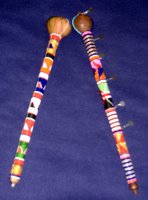
At the end of the worship, they presented gifts to all of us present. Since I was the one who preached, among the gifts, I was given a Rungu. It is a club with a large head on it that was originally used for hitting and defense. It later came to symbolize a Masai chief or elder and finally a Masai leader. Ask to see it if you are in my office. It will be on display. After all not many white men ever get to be Masai chieftains!! 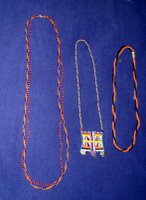
A very touching moment occurred with us barely noticing it. One of the women came forward and spoke softly to the Pastor during the final singing. After a moment he nodded “yes.” What we later realized was that she had gone around after getting the Pastor’s permission and collected necklaces from the women. At the presentation, they came forward and put the very necklaces they were wearing around our neck. That was a very moving experience.
They also had prepared personalized Masai bracelets for every member of our team in Kenya. To really get the picture here, you need to visualize the bracelets. They are leather straps with hundreds and hundred of beads strung in rows around them. Here is what is amazing – all of our bracelets had our names on them. It is hard to imagine how much time and planning went into the making of each bracelet. The exact placement of every bead had to be carefully planned.
After worship we went outside and as is a custom here we are very quickly learning, had a “soda,” – Coca Cola and Fanta Orange. (Please note here, Coke not Pepsi!) We then had photo ops with the various folks. The women who made our bracelets all wanted to have their picture taken with us. I am going to mail it to them upon my return.
In the afternoon beginning around 3:00 (it took that long to get back from worship since it was not over until 2:00) we had lunch with seven pastors. It was very interesting to hear some of their stories. When we asked what their needs were, they responded two things: prayer and training. For most of them all they have is a Bible, if that. I thought about all the training we pass up in the states as Pastors while these men were begging for some.
In one very challenging event, we heard the story of one pastor who came close to being beaten for the cause of Christ. He stood up to one community leader and told them he would not permit them to force a certain young girl to marry an older man. When one of the chiefs said he would beat him, the pastor turned his back and said, “Which side do you want to start on, because I will not permit this to happen!” I could not help but think of the issues and pressures we so easily cave in on in the United States.
Wednesday, November 09, 2005
Out of Africa: Part 7 – African Worship & Community Needs
On my recent trip to Africa, I disciplined myself to keep a daily journal of what transpired and how I felt about it. These entries are from that journal.
Sunday, October 23, 2005
Experience #1 - Worship in Africa
This was a busy and very intense day, so to keep this entry from being too long, I will break it into several entries. We began the mid point of this journey as every day with a communal breakfast. After breakfast we departed for two separate churches for worship. Joshua and I would worship at a Masai congregation while Gary would go with John (World Vision US rep) and his 20 year old son Taylor to worship at a Kisipigi congregation.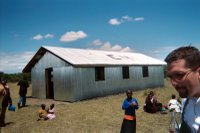
We arrived at our gathering shortly after 10:00 am. Folks were already inside singing. One of the leaders of the church told me that the folks would be slow arriving because the Masai have work they must do with their cows before they can come to worship. Folks continued to arrive for the next hour.
We later learned that this was a combined worship of four churches gathering together. It was not until 11:15 that everyone, including the primary pastor arrived. Worship then went on for another two hours. It included more singing, testimonies, two primary sermons, and 3-4 mini ones.
There were some similarities in their worship to our own, but it was not a 100% cross over. Their singing is in responsive chanting using only a single drum. The women are the primary leaders since in this culture the women will sing to the men anyway. However, one visiting Pastor did lead one song.
The primary pastor (red tie in the photo between Joshua and me) reminded me of my first pastoral mentor, Richard Horn. My son Richard is named for this man; that is how highly I respected him, so this is not small passing praise I am offering up here. He walked like him, carried himself like him, preached like him and even moved among the community folks with the respect that I have never seen in any man except Richard Horn.
me of my first pastoral mentor, Richard Horn. My son Richard is named for this man; that is how highly I respected him, so this is not small passing praise I am offering up here. He walked like him, carried himself like him, preached like him and even moved among the community folks with the respect that I have never seen in any man except Richard Horn.
This pastor and I both gave the two primary sermons in the worship. What a great treat! I shared with them the story that crept into my conscious during the worship. When I was still in seminary, I heard a missionary speak who worked with the Masai. He showed some photos of the Masai, and asked us to pray for them. I recalled praying for the Masai, never in a million years imagining that I would be worshipping with them and preaching in their congregation some thirty years later.
During the introduction they apologized for the worship being in their language and not in English. When I arose, I said it was we who should apologize for not knowing their language, not the other way around. Prior to rising, I asked one of our interpreters how to say, “Praise God,” in Masai. It is “Meisisi Yesu,” which is literally “Praise Jesus.” I wanted to show respect for their language so at the end of the message I said “Meisisi Yesu!” The look of delight and joy on their faces told me that I had indeed done the right thing.
Their method of taking up an offering was unique. They put three large bowls on a bench in front. Each was a different color. The pastor said that one was regular offerings, the other was tithes, and the other was fo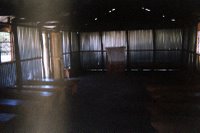 r special offerings. I am not sure of the distinction between them, but the Masai clearly knew what was taking place. Then they sang while folks filed forward putting in their offering of Kenyan Shillings. I put in some shillings myself. But what was most moving, one woman carried forward a bag of seeds she had brought to worship. As she laid them on the bench, I prayed for her. I have no idea who she is, and will probably never meet her again until I get to heaven, but I have prayed for her numerous times since that day.
r special offerings. I am not sure of the distinction between them, but the Masai clearly knew what was taking place. Then they sang while folks filed forward putting in their offering of Kenyan Shillings. I put in some shillings myself. But what was most moving, one woman carried forward a bag of seeds she had brought to worship. As she laid them on the bench, I prayed for her. I have no idea who she is, and will probably never meet her again until I get to heaven, but I have prayed for her numerous times since that day.
Tuesday, November 08, 2005
Out of Africa: Part 6 (Continued) – First Community Visits
On my recent trip to Africa, I disciplined myself to keep a daily journal of what transpired and how I felt about it. These entries are from that journal.
Saturday, October 22, 2005
Experience #2 - A Schoolyard Celebration
After lunch we visited the Engudi School for Masai children. We all felt the opening welcome when we arrived yesterday was incredible. And it was. But we had not seen anything yet. We learned full well the Africans have a great love for ceremony. We knew we were heading to a school and they were expecting us. But we had no idea of what was about to transpire.
After driving down a slight grade toward the school area, we crossed an open field to the “gate” entrance to the school. There in front of us were several hundred children in full Masai dress and lined in a military precision. As we exited our vehicle, they came toward us dancing, singing, smiling and looking for us to touch their head and bless them. Girls who had been selected approached us and presented us a “stick.” (Actually a small branch of a tree that was stripped and clean. It is what the Masai use to shepherd the cattle.) They then took our hands, one girl on each hand, to lead us to the area where the p rogram would be about 100 yards away. We were seated in seats of honor in preparation for the program that had been prepared. As we walked I could not help but notice that the girls would lightly rub or touch the top of my hand. I was reminded that I had been told that I was the first white man many of them had ever seen, and they were feeling my skin to see that it felt the same as theirs. Tell me that does not give you the chills!
rogram would be about 100 yards away. We were seated in seats of honor in preparation for the program that had been prepared. As we walked I could not help but notice that the girls would lightly rub or touch the top of my hand. I was reminded that I had been told that I was the first white man many of them had ever seen, and they were feeling my skin to see that it felt the same as theirs. Tell me that does not give you the chills!
We were given Coca Cola or Fanta Orange and greeted very warmly by the dignitaries present. There was an elder, a former chief, a government official, numerous school officials and probably more than a hundred parents. Folks were literally climbing up in the trees to get a full view of the day’s events. It was apparent they had been preparing for this day a very long time and it was one of the biggest events to occur in this community for a very long time.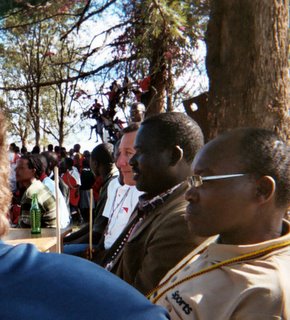
We had numerous dances and songs by the children of all ages. The women performed a song for us. We even got to see some of the legendary Masai jumping ability! There were speeches, presentations, and gifts, and an opportunity for each of us to address the crowd. I was more in awe than I think I have been at any time in my life. Actually, there may have been times that rival this one, but there were not many!
Following the program we visited the classrooms of the school, mingled with the folks and had some photo opportunities with the children. Here are some facts about the school itself.
* Started 1950
* The Headmaster was a former student here.
* Current enrollment 290 Boys, 160 Girls (shows the need to empower women and to keep girls in school and out of early arranged marriages.) The gender ratio is about equal until grade four or five.
* Eight classrooms, two are permanent
* Six teachers (Do the math here. There should be a student: teacher ratio of 40:1 at most. It is 90:1!)
* They use water from Mara River, sometimes water is contaminated by sewage dumped upstream.
* School has only three (3) toilets (one for boys, girls, and staff)
We were at the location a couple hours. After greetings and photos, we got in the vehicle to drive back. By then we were hungry and our host had prepared some sandwiches for the long rough drive back. One of the members in our group picked up a parasite probably from not using a hand disinfectant after shaking so many hands. In my vehicle I had brought it we did use it and I was able to explain to our African hosts why we did. We explained that our bodies all build up immunity to the bacteria we are in contact with regularly. Our bodies are not used to the bacteria in their culture and it would make us very ill, as happened to Taylor. We also told them that if they were to come to America, they would probably have a similar issue in our culture. We wanted to be sure they fully understood that we did not look down on them in the least. It was simply a matter of immunities.
The vehicle carrying our African hosts took off and drove like crazy to get home well ahead of us. This is no small feat considering the terrain. When we finally got back we realized why. They had rushed back to prepare us tea and cookies and a time to relax before dinner. The hospitality is legendary here, and we were experiencing it first hand.
As I debriefed the day’s events with Gary, Joshua, John, Taylor and our hosts, I was once again very humbled by the incredible experiences of this most significant day in my life.
Out of Africa: Part 6 – First Community Visits
On my recent trip to Africa, I disciplined myself to keep a daily journal of what transpired and how I felt about it. These entries are from that journal.
Saturday, October 22, 2005
Experience #1 - The Hidden Affects of HIV
After breakfast this morning we all piled into the Toyota four wheel drive vehicles and drove to spend the morning visiting four family units. We learned later in the day, that our presence could go a long way toward validating their work among the people and making things a bit smoother as this ADP (Area Development Project) moves to the second phase in this area. The roads in many places were almost non-existent. It was the roughest terrain you can imagine to drive a vehicle on. Because it rained the night before it was even worse. Our four wheel drive vehicles became stuck three or four times and took much effort to get them out or not turn them completely on their side due to the grade of the hill we were riding on.
All of the family units we visited are in the Kipsigi tribe. The Kipsigi are farmers unlike the Masai who are herdsmen. This means that they own and inherit land where in the Masai the land is communal. It is not owned by any individual. I learned very soon that there are good and bad things in this. The Biblical comparisons are uncanny. Only Kipsigi males can inherit land and they must be 18 to do so. As you continue to read notice how that comes into play in negative ways.
The first person we visited was Jonah. (Pictured in center fifth from the right.) Numerous folks here have a Biblical name in addition to their African name that we would have a hard time 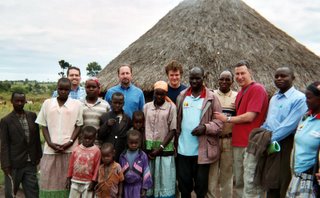 pronouncing! Jonah had two wives, both of whom died of AIDS-related illness. He is left with 14 children and grandchildren to care for. He is living positively (one of only 5 out of 50,000 in the entire ADP area who is doing so.) Currently he is only occasionally sick with minor infections. One goal is to remain healthy and live long enough for one of his male children to reach an age they can inherit what he has so no other family member could come and take it.
pronouncing! Jonah had two wives, both of whom died of AIDS-related illness. He is left with 14 children and grandchildren to care for. He is living positively (one of only 5 out of 50,000 in the entire ADP area who is doing so.) Currently he is only occasionally sick with minor infections. One goal is to remain healthy and live long enough for one of his male children to reach an age they can inherit what he has so no other family member could come and take it.
We walked into his round hut, which has a grass roof, mud walls, and dirt floor. It actually is a pretty cool piece of construction. It was full of the smell of smoke due to the fire inside it. It has one larger room that I estimate to be about 15 feet by ten feet. There was another room off to the side that was about ¼ that size. The opposite wall had one window. Imagine 15 people living in this space, while we complain we are cramped in our “small houses” with no storage. But I digress . . .
The second family was headed by Phillip Nyatich (22). He lives with his two brothers Jackson (16) and Kosmas (14). Their parents died of AIDS related illnesses about five years previously. Phillip is sole breadwinner; works when he can find it for 50-70 Ksh (Kenyan Shillings) per day (70 Ksh = $1). He often can't find work. It is likewise difficult to find or buy seed and plowing money. When he gets seed he often cannot cultivate his land. He has to rent a plow . . . you get the picture. They have no money, to pay for education. Primary school is free, secondary school must be paid for.(And we take for granted our education in the United States!! But again, I digress . . .) Phillip qualified for secondary school before his parents died but was unable to attend due to financial concerns.
When we asked Phillip his dreams he said, it was for his brothers to go to secondary school, study, get good jobs, and to have capital for livestock trading, and planting on his 2 acres.
Family number three was headed by Wesley (18). He lives with wife (16), younger sister (grade 5), brother (grade 3) and grandmother. His mother never married and later died of AIDS related illnesses, so when grandmother dies the land will pass to her son bypassing Wesley. They are for all practical purposes homeless. He works at a local mill for 30 Ksh/day. Everyone besides him and his wife must search for a place to sleep every night. He married early to find help in taking care of the family.
We asked him what we could pray for. He said that he will somehow be able to find land to care for his family. Remember, he is eighteen years old!!
The saddest story of all was our fourth visit. This young man was also named Wesley. He is 17. The entire community believes his father wa s the local source of HIV. They in turn blame him and his family for the sickness. They were, relatively speaking, wealthy. The two huts on the land are in disrepair because Wesley was forced to run away the stigma is so great. He had 2 younger sisters and a younger brother. They were taken in by far-away relatives and he has not seen them in many years. The next door relatives refuse to help him because of the stigma.
s the local source of HIV. They in turn blame him and his family for the sickness. They were, relatively speaking, wealthy. The two huts on the land are in disrepair because Wesley was forced to run away the stigma is so great. He had 2 younger sisters and a younger brother. They were taken in by far-away relatives and he has not seen them in many years. The next door relatives refuse to help him because of the stigma.
He lives with his uncle in a hotel that was once his father's and should belong to him. Do not even let your mind think of hotel the way we envision it here in the states. The rooms are about 6x8 with nothing but a wooden stick bed and a dirt floor. The uncle would owe him rent for the hotel so he trades the rent to be able to eat at the hotel. The primary use of a hotel in Kenya is to eat not stay overnight.
Simon Ole Masi said he has never seen anything exactly like this. A family is pretty well off but so shunned, they cannot even make use of what they have. For him to say this is a powerful statement since he has seen the devastating effects of the HIV stigma many times.
Fortunately the local headmaster at his school is understanding of his situation and has waived his secondary school fees up to this point. Wesley wants to become a doctor and work on a cure for AIDS. His best subject is biology – fits doesn’t it? - (normally scores around 700/1100). He stands to inherit the land that formerly was his father’s, but cannot if the uncle takes it. This very well may happen since Wesley is about to turn 18 and the uncle may see this as the time to move and take possession before Wesley is of age. Since the stigma and shunning is so strongly directed at this family the community would do little to make the uncle feel he is doing anything wrong.
Saturday, November 05, 2005
Out of Africa - Meeting the Community Photos
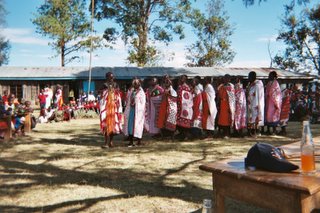
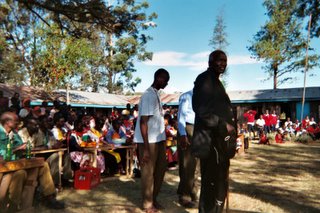 Photos here include an elder in the community addressing the crowd of over 300 assembled to meet us at the school and the teens and women dancing in the native attire. You can see the presidential representative sitting with us. He is the second from the right. The man with glasses is Simon Ole Masi whom I have been writing so much about. Above him look in the trees at folks climbing so they can see! The last photo is of the Kisipgi man we visited. He is HIV positive and is one of only 5 folks in the 50,000 in the area who are living positively and publicly with HIV. He lives in the hut behind with his 14 children and grandchildren hoping to live long enough so one of the males will be 18 years of age so they can to inherit his land.
Photos here include an elder in the community addressing the crowd of over 300 assembled to meet us at the school and the teens and women dancing in the native attire. You can see the presidential representative sitting with us. He is the second from the right. The man with glasses is Simon Ole Masi whom I have been writing so much about. Above him look in the trees at folks climbing so they can see! The last photo is of the Kisipgi man we visited. He is HIV positive and is one of only 5 folks in the 50,000 in the area who are living positively and publicly with HIV. He lives in the hut behind with his 14 children and grandchildren hoping to live long enough so one of the males will be 18 years of age so they can to inherit his land.
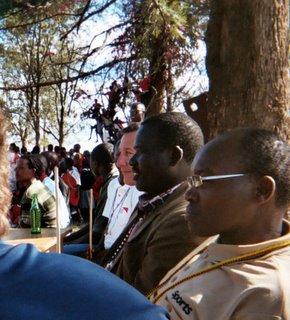
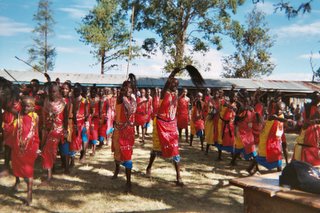
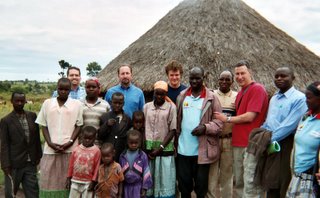
Out of Africa - Travel to Masai Photos
Out of Africa - Sunday Worship Photos
Out of Africa - Orientation Photos
Thursday, November 03, 2005
Out of Africa: Part 5 – Arrival with the Masai
On my recent trip to Africa, I disciplined myself to keep a daily journal of what transpired and how I felt about it. These entries are from that journal.
Friday, October 21, 2005
After driving over 300 kilometers in sub-Sahara Africa in a four wheel drive you have a new appreciation for the roads in the United States, no matter how bad they are. We drove for over two hours of this seven hour journey over roads where there were no roads. We drove where the safari vacationers were, only we kept going. There is something very unique about riding down the road, paved and unpaved, with zebra, wildebeest, giraffe, warthogs walking beside the road with the sheep and the cattle. The funniest part of the journey, was to see road kill beside the road, much as in the states, except the animal killed was a zebra!
That was the easy part of the journey. I had no intestinal issues, and no near death experiences, but I did have a near life experience once I arrived. It impacted me tremendously. Here are some details of that experience.
We came down the dirt “road” to where the Area Development Program was located and saw something that I will never forget as long as I am allowed to breathe air. There, lining the road waiting for us, (we were 90 minutes late!!) were several hundred Masai Tribesmen. There were men, women, children, boys and girls. Lining the road, dressed in their best colorful attire (matching for the children) singing to us and swaying as we drove past. They were waving to us and acting like we were visiting dignitaries! They followed the cars in on foot, and when we stepped out, the children came upon us singing and one after the other asking to be blessed. We were then told by World Vision’s Project Manager (an amazing African man – that in itself would be another blog) that they would like us to make our way to the stage for a short program.
We went to the stage area and were given the seats of honor. There small children continued to come up to us to place our hands on their heads to bless them. Some of these kids were the age of my grandson Gavin. I wanted to cry but that is the ultimate sign of weakness among the Masai. Also, it is hard to shed tears when they seemed so joyful. These precious human beings felt better because I touched them! There is something incredibly humbling about that experience.
It began to rain so we suggested turning the stage so almost everyone could get under shelter. They were going to do this entire program standing in the rain while we sat in the dry if we had not made this suggestion. The Manager gave the layout of the program (aided by an interpreter) with us as the guest of honor and opening prayer. He once again welcomed the visiting guests from America and they began the program.
The smallest children gathered in front and sang praises to God in the Masai tongue. Simon leaned up to me from behind and translated the words they were repeating as they sang and danced. It was then he told me that this was the first time many of these children had ever seen a white man in their life! Next the older children sang songs similar but more mature, also about praise to God.
Finally the women came forward and sang to us. I was reminded that the night before Simon told us the women sang to the men. As they sang, one of them came to each of us and presented us with a bracelet. My hand was too large for it, but oh how I wanted to force that bracelet on! Tears wanted to come once again, although I choked them back.
Finally the women did a skit, as the entire group laughed. The skit was about a woman in labor, with the purpose to show us they needed a maternity clinic here. Women die often in childbirth, or it was very difficult and the travel out for assistance was all but impossible. I was reminded again of one of World Vision’s primary objectives to assist in the HIV fight was the empowerment of women in the communities as the cultures could adapt and accept. This one already saw the need on some level.
A political representative of the President came forward to extend his welcome and greeting. Along with one of the World Vision personnel from Africa who reminded everyone, what they knew, but we did not, that because it was raining was a good thing. Rain here is a sign of blessing, and this showed God was going to bless our next four days among the Masai.
Afterwards, each of us was invited, to give a greeting which was translated for the entire community. The ceremony closed in prayer and we were escorted to the guest quarters, where I now sit. There is no doubt in my mind, that this is the nicest place to stay for 50 square miles aside from expensive Safari hotel locations. The people we are here to meet live in huts, I had a room in a building.
Once in the house, they served us coffee and cookies as we sat and talked about their plans for us for the next four days. They have been planning and preparing for our visit for MONTHS I was told.
We conversed about what the community both wants and needs and their plan with World Vision to bring that about and release total control of everything to the local people by sometime around the year 2018.
We were given 30 minutes to rest before they gave us our dinner. It was served buffet style and included soup, salad, vegetables, mutton, goat and fresh fruit.
I now sit in this room writing and asking the same question I asked on opening night, “God what are you up to?”
Check back, photos will be added later today.
Wednesday, November 02, 2005
Out of Africa: Part 4 – Learning how to Change the World
 On my recent trip to Africa, I disciplined myself to keep a daily journal of what transpired and how I felt about it. These entries are from that journal.
On my recent trip to Africa, I disciplined myself to keep a daily journal of what transpired and how I felt about it. These entries are from that journal.
Thursday, October 20, 2005
I learned a lot about World Vision today. They have been around over 50 years doing relief work and holistic ministry among the poor. Presently they are serving in 100 nations. They are definitely not an American ministry. They employ 13,000 world wide. Only 800 are in the United States. That is less than 5%. They pay a good wage to get good people and therefore many other ministries are envious of them. But the respect they have in communities from the people is pretty impressive.
To get an understanding of what takes place, I jotted down these key elements of holistic ministry as seen through World Vision.
1. Transformational Development - this includes:
*The well being of children and families
*Empower children as agents of change
*Transform relationships
*Interdependent and empowered communities
2. Transition systems and structures
3. Emergency Relief
4. Promotion of Justice
5. Public Awareness
6. Witness for Jesus Christ by life, deed, and word to encourage people to respond to the gospel.
7. Respect dignity of life
The goals are long range:
* Assess needs with the community
* Design a plan based upon research
* Implement the plan (3-12 years)
* Monitor and Evaluate
* Reflect and learn from the process
* Transition total control to the community (12-15 years)
Some key elements of this Church to Community sponsorship program.
1. Child sponsorship dollars go to the community – thus assisting the child you are sponsoring and the entire community.
2. Each community decides their own priorities. World Vision does not dictate to them.
3. HIV education, prevention and assistance is interrelated in all aspects of their ministry.
4. The model of church engagement is church to community not church to church.
5. African staff and communities make the decisions not Americans.
Here are some startling statistics they shared with us that are pretty eye opening.
Every 1.2 seconds a child is born into poverty
Every second a child is infected with HIV
Every 2.1 seconds a person becomes a refugee
Every 3.6 seconds a person dies from malnutrition
The afternoon was set up for a time to visit a giraffe park and the Karen Blixen estate. (The movie Out of Africa is set there.) I was told by some folks that it is not really that great, so I skipped out on that trip to catch up some reading, journaling, and a nap!
This final night in the Orientation phase, we sat with our teams for dinner. Our team will be led by Simon Ole Masi. It means “Simon son of Masai.” He is a Masai elder himself, so this makes for great ministry. He is very excited that we will be among his people. The more I talk to him, the more impressed I am with him.
There are three pastors visiting this Area Development Project. Joshua is a Church of God Anderson, Indiana pastor serving outside of Indianapolis. Gary is a Grace Chapel Pastor from Fort Lauderdale, Florida and of course me. I cannot say for sure, but I think we are going to hit it off.
We will meet two primary tribal groups the Masai and the Kipsigi. The Masai are warriors and herdsmen who do not own land. The land is for the community. They all share grazing on it. The Kipsigi are farmers so they own land. They used to be at war, but now are in a time of peace. There is an excitement building and there is likewise a bit of fear developing. Gary told us he has never been on a Mission trip where he did not get gravely ill from the food, climate, etc. But he is here because God told him, through his wife to come. When I heard that, I compared my situation. My family is not why I am here, but I have to give them credit because they did not get in my way or make it difficult so I would be distracted while here. That would surely have limited God’s working.
We depart tomorrow morning just after breakfast. We will have a six hour ride in four wheel vehicles that will cover about 350 kilometers. The first 120 are decent roads we are told. When we asked him about the others, Ole Masi just laughed.
On a side note, I will have some photos up tomorrow.
Tuesday, November 01, 2005
Out of Africa: Part 3 – When Orientation is Dis-Orienting
On my recent trip to Africa, I disciplined myself to keep a daily journal of what transpired and how I felt about it. These entries are from that journal.
Wednesday, October 19, 2005 The day’s orientation, lasting from 8:00 am until 1:00 pm was spent in HIV and AIDS training. The training was led by a man and woman from South Africa. Ernest, the African is one of the top African officials in World Vision. The primary “trainer” regarding HIV was Logy (pronounced Low-ge with a hard “g”). She was a former social worker who now works with World Vision in the HIV battle. Her father named her while studying Greek. Her full name is Eulogia which is Greek for “Blessing.”
The day’s orientation, lasting from 8:00 am until 1:00 pm was spent in HIV and AIDS training. The training was led by a man and woman from South Africa. Ernest, the African is one of the top African officials in World Vision. The primary “trainer” regarding HIV was Logy (pronounced Low-ge with a hard “g”). She was a former social worker who now works with World Vision in the HIV battle. Her father named her while studying Greek. Her full name is Eulogia which is Greek for “Blessing.”
As we talked about HIV the stats basically were nothing new. In truth, the statistics was one of the primary items God had used to prime my heart for this trip in the first place. It was interesting to learn that India is overtaking Africa in new infections and that the Eastern European block of the former Soviet Union has the highest percentage of new infections per capita.
The knowledge about how the disease spreads was basically already in my knowledge bank as well. There were facts of which I was made more keenly aware. For example, the method of mothers transferring the disease to the child was made clearer. It is through the blood that is involved in childbirth and through nursing, but not through the pregnancy period since there is no exchange of bodily fluids during pregnancy.
The bodily fluids that carry the highest concentration of the HIV virus are semen, vaginal fluids, blood and mother’s milk. These fluids make the risk of infection especially high. Saliva, tears, urine have a much lower concentration and the risk of infection is likewise very low.
I learned a bit more about how the virus operates. One of the facts that make the HIV virus so dangerous is that it, not unlike the flu virus or the cold virus, mutates regularly. This makes it much more difficult to attack because there are so many strains. This fact alone means that if a couple were married who both were HIV positive, they should not have unprotected sex because they could be carrying different strains of the virus and then both compromise their immune system further by running the risk of double infection.
HIV (Human Immunodeficiency Virus) is so dangerous because of the method it attacks the body. HIV, as the name suggests attacks the body’s immune system. It is a very insidious virus. The HIV virus attaches itself to the body’s T-cells. The T-cells are the “generals” as it were who direct the immune system to attack any invader. This virus causes the T-cells to not alert the body’s natural defense mechanism. In time the T-cells will actually reduce in number. It is then that the person is diagnosed with AIDS. A healthy body will have a T-cell count of 800-1200. Once it drops below 250, the person is said to have AIDS. In reality the only thing that has changed is that the body has a lower count of protecting T-cells due to any number of reasons.
In reality, no one dies from AIDS. They are said to die of AIDS related illnesses. Opportunistic viruses, such as flu or pneumonia, etc. can have a more deadly affect, and cause de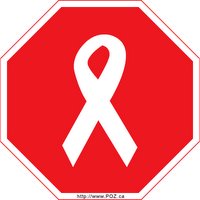 ath, because the body’s natural defense is shut off.
ath, because the body’s natural defense is shut off.
This is distinct from another attacker of the human body . . . cancer. Cancer cells are the body’s own cells. They are renegade cells that are attacking the body rather than promoting health. Since they are the body’s own cells, albeit renegade, the body will not attack them, and they cause all manner of illness and death. Both illnesses prevent the body from defending itself, but by very different means.
So much for my medical expertise. (My doctorate was not in medicine, so if I have some errors, please excuse me.) Even this is just the tip of the ice berg of what these hours were like.
There were items I would change in the training, but all in all, it was a worthwhile time. In the developing world of Africa, the empowerment of women is seen as a key component in the battle against HIV and AIDS. Women have little if any rights in most of the countries. That will come to bear in a much more real way as the week goes on and I will share some more of that.
An interesting take on this pandemic can be found in this interview with Bono in the New York Times. You may have to take two minutes to create a login account.
During the afternoon we boarded a bus and took a shopping excursion to a local shopping district. The area was close and tight like I have seen in the Middle East, and there was likewise a lot of pulling you toward their booth in that vein. I have to admit I was not overly excited because I, like most men, do not like shopping. I wanted to get gifts for the significant people in my life, and for the folks who sponsored me to come here, that alone was why I was here. I was about to learn something about myself.
I have always thought I hated to haggle over prices. Our Kenyan host told us that the quoted price was always the beginning place to negotiate down. The experience actually became fun. I wanted to pick up some gifts for my family, a few friends and the folks who had given financially to make this trip possible. I began to enjoy the haggle so much that I got some good deals. Our host said not to worry, even if we had a good deal, they will not sell if they do not make some profit. That is good, because I did not want to take advantage of anyone. But perhaps I learned something about myself. I may be better in the states if I had the cash to be in a position to discuss. All I all, this was a good diversion after the morning sessions.

